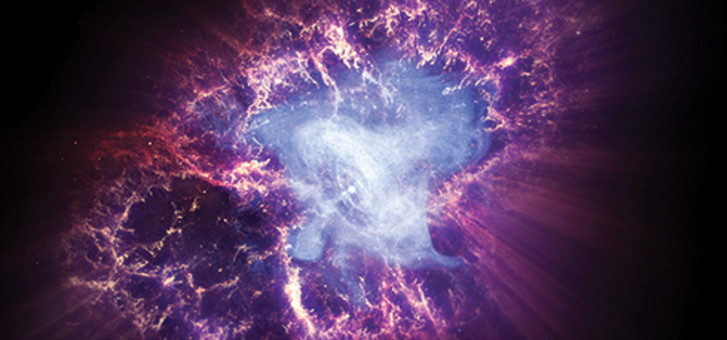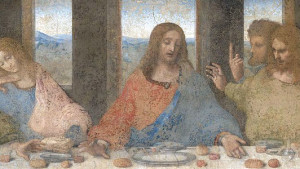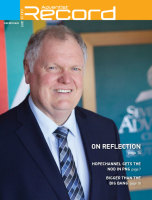For centuries the Bible has resolutely proclaimed that in the beginning, God created the universe. This teaching was at odds with Aristotle’s influential theory of an eternal, unchanging universe.
All this changed in 1824 through the work of French military engineer and physicist Nicolas Léonard Sadi Carnot, the first person to formulate the second law of thermodynamics. The law states that the processes taking place in an isolated system always tend toward a state of equilibrium. Since the universe is not in an ultimate state of equilibrium now, it could not have existed for an infinite amount of time. Thus, science could now offer its support for the profoundly significant biblical position that the universe actually had a beginning.
While working on the general theory of relativity in 1917, Albert Einstein also found that his theory would not support an eternal, unchanging universe. Two scientists, Alexander Friedmann and Georges Lemaître, continued to work on applying the general theory of relativity, and in the 1920s they independently reached the conclusion that the universe is expanding. The theory predicted that all of space and time originated from a single point and has expanded to the immense universe that we know today. This expansion became known as the “Big Bang”. Once again science supported the reality that the universe had a beginning.
There are Christians who feel the need to integrate the Big Bang theory into their theology because they believe that the weight of evidence requires them to do so and because they don’t want to be perceived as anti-science. This is understandable but there is the real danger that this approach could lead to promoting a physical process that God did not actually use in creation and adopting a scientific theory that will ultimately become obsolete.
In order to catch a glimpse of how God created the universe it's important to carry out a study of passages in the Bible regarding Creation. For example, the book of Hebrews acknowledges that it is “by faith we understand that the universe was created by the word of God, so that what is seen was not made out of things that are visible” and the psalmist tells us that “by the word of the Lord the heavens were made, and by the breath of his mouth all their host".1 This reveals that the universe was spoken into existence by God.
Does the Big Bang theory integrate smoothly with this biblical insight? It's important to note that the Seventh-day Adventist Church has neither formally nor informally endorsed the Big Bang theory. But should we as individual Seventh-day Adventist Christians feel intellectually obligated to adopt and defend the Big Bang theory? There are a number of reasons why we should not.
Firstly, the Big Bang theory is not the only theory that can fit the data.2 The Christian cosmologist George Ellis has explained, “People need to be aware that there is a range of models that could explain the observations . . . What I want to bring into the open is the fact that we are using philosophical criteria in choosing our models. A lot of cosmology tries to hide that.”3 Even the famous cosmologist Stephen Hawking, who is now an atheist, recognised this when he wrote, “One can imagine that God created the universe at literally any time in the past . . . One could still imagine that God created the universe at the instant of the Big Bang, or even afterwards in just such a way as to make it look as though there had been a Big Bang.”4 Thus, the weight of evidence does not lead inescapably to the Big Bang.
Secondly, the Big Bang theory itself is not free of problems. It's based on an assumption called the cosmological principle, which holds that matter is distributed uniformly throughout the universe. As the theoretical physicist Richard Feynman notes, though: “The assumption that we have just mentioned implies a very strong uniformity in the universe. It is a completely arbitrary hypothesis, as far as I understand it.”5 The standard Big Bang theory also has other problems;6 to solve these problems the standard model has been patched up with inflation, dark matter and dark energy. Is it time for the Big Bang theory to be traded in for a new model?
Scientists themselves see the need to explore other models of the universe. In 2004, 33 scientists wrote an open letter to the scientific community, urging them to support the exploration of alternative models to the Big Bang theory.7 Then in February this year, Ahmed Farag Ali and Saurya Das proposed a new cosmological model that eliminates the Big Bang.8 Wrapping our theology around scientific theories turns out to be a misguided endeavour.
History warns us not to credulously adopt and defend the dominant cosmology of our day. Contrary to popular belief and according to Galileo’s own account, the Galileo affair was initially between Galileo and the academic Aristotelian professors of the day.9 Galileo challenged the Aristotelian-Ptolemaic cosmology, and, as Hawking has noted, “This annoyed the Aristotelian professors, who united against him seeking to persuade the Catholic Church to ban Copernicanism.”10 The critical mistake that the Catholic Church made was to credulously adopt and then repressively defend the dominant pagan Greek cosmology of their day. Adventist academics would be wise to learn from the Galileo affair and not make the same mistake the Catholic Church did, by adopting or defending the dominant cosmological theory of our day. That some have recently made that mistake publicly is tragic.11
Finally, the reality is that we already reject key projections of the Big Bang theory, namely what it predicts about the future. Current observations suggest that the universe is expanding at a rate that will end in what is known as the Big Freeze. Accordingly to this theory, the universe will ultimately become one vast, cosmic graveyard for all of life, including humans.12 However, we reject the Big Freeze because of the biblical prophecies that Jesus will come again in the near future and create a new heaven and a new earth.13 Since we reject the future projections of the Big Freeze based on biblical revelation, we should similarly choose to uphold God’s revelation regarding our past over the historical projections or theory of the day.14
Adventists should certainly recognise the hard work that cosmologists devote to studying the universe and their ongoing efforts to develop models to describe it. However, we should not credulously adopt the Big Bang theory. Like the Catholics who defended Aristotle’s view of the universe, Adventists who mould their theology around the Big Bang theory not only give up theological credibility but are likely to be left behind as science moves on from the Big Bang.
God has given us the ability to discover amazing things about the universe. He has also given us the ability to grow in our faith in Him, to believe by faith in a God who can create a universe in any way He wants to. A God who can establish physical laws and then intervene to perform supernatural miracles. A God who is willing to enter into this physical world and become flesh, just to reveal to us His love and power. A God who is bigger than the Big Bang, who is wiser than the wisest man, and who gave us insights into our origins that outlasted Aristotle and Einstein, and will outlast Hawking also. Let’s learn the hard lessons of the past and base our theology on His Word, not on the shifting sands of theoretical physics.
- Hebrews 11:3 and Psalm 33:6 (ESV).
- Scientific theories tend to be underdetermined by the evidence, which means that more than one theory could be matched to the data. Refer to John Lennox, God and Stephen Hawking: Whose Design is it Anyway?, Lion Books, 2011, p 65.
- Gibbs, W W, Profile: George F R Ellis, Scientific American 273(4):55, October 1995.
- Stephen Hawking, A Brief History of Time: From the Big Bang to Black Holes, Bantam Books, 1988, p 10. In acknowledging that God could have created the universe at literally any time after the instant of the Big Bang, and specifically in the case that the universe was more recently created, say in the order of thousands of years ago, Hawking sweeps away the starlight problem and objections based on deep-time dating models, such as radiometric dating, continental plate tectonics, the geological column, ice cores and evolutionary timescales for the biosphere, in one fell swoop.
- Richard P Feynman, Fernando B Morinigo and William G Wagner, Feynman Lectures on Gravitation, ed. Brian Hatfield, Addison-Wesly, 1995, p 166.
- These problems include: (1) the horizon problem, (2) the flatness problem, (3) the magnetic monopole objection, (4) the rotation curves of spiral galaxies, and (5) distant supernovæ being dimmer than expected. It is fascinating to note that the horizon problem involves the issue that, within the standard Big Bang theory, there is insufficient time for information and energy to travel between regions of the universe because of the physical limitation imposed by the speed of light. John Hartnett has observed, “Some of the solutions proposed [for the horizon problem], such as a massively higher speed of light in the past, or rapid inflation, have been no less exotic than any put forward by creationists.” John Hartnett,Starlight, Time and the New Physics, Creation Book Publishers, 2007, p 21.
- Available online at <https://web.archive.org/web/20140401081546/http://cosmologystatement.org> and Lerner, E. “Bucking the big bang”, New Scientist, 182(2448):20, 22 May 2004.
- This model was announced in <http://phys.org/news/2015-02-big-quantum-equation-universe.html>. It is important to note that there have been many other cosmological models proposed, including oscillating models, Linde chaotic inflationary model, Vilenkin and Hartle-Hawking quantum gravity models, and the Caroll-Chen model that relies on a background de Sitter space-time. Refer toReasonable Faith, p125-150.
- Refer to Galileo’s letter to Kepler in 1610, which is available at <http://law2.umkc.edu/faculty/projects/ftrials/galileo/lettergalileokeplar1610.html> and his famous letter to the Grand Duchess Christina of Tuscany in 1615, which is available at <http://scitech.au.dk/fileadmin/site_files/science.au.dk/NF/Komm/DenbevaegedeJord/Letter_to_the_Grand_Duchess_Christina_of_Tuscany.1615__Gallilei.pdf>.
- A Brief History of Time, p 189. John Lennox has also confirmed this historical corrective: “Furthermore, Galileo enjoyed a great deal of support from religious intellectuals—at least at the start. The astronomers of the powerful Jesuit educational institution, the Collegio Romano, initially endorsed his astronomical work and fêted him for it. However, he was vigorously opposed by secular philosophers, who were enraged at his criticism of Aristotle. This was bound to cause trouble. But, be it emphasised, not at first with the church.” John Lennox, God’s Undertaker: Has Science Buried God?, Lion Books, 2009, p 24.
- It is sobering to realise that Christian academics who are defending the dominant cosmology of our day are playing the contemporary equivalent to Professor Cosimo Boscaglia’s historical role in the Galileo affair rather than Galileo Galilei and Benedetto Castelli’s historical roles. For the historical context, refer to Moss, J. “Galileo’s Letter to Christina: Some Rhetorical Considerations”, Renaissance Quarterly, 36 (4): 547-576, 1983. Available at <http://www.jstor.org/stable/2860733>.
- Reasonable Faith, p 143.
- Isaiah 65:17 and Revelation 21:1-4.
- As Craig has pointed out, “Theological eschatology therefore takes the findings of physical eschatology to be at best projections of the future course of events rather than actual descriptions.” William Lane Craig, “The End of the World”. Available at <http://www.reasonablefaith.org/the-end-of-the-world>. In a similar way, physical cosmogonies can be taken to be at best projections of the history of the universe rather than actual descriptions. It should be noted that no evangelical Christian supposes that God will take billions or even millions of years to create the new heavens and the new earth. The biblical symmetry between protology and eschatology would then support a much shorter protological timescale.
Dr Sven Östring is director of Personal Ministries, Sabbath School, Stewardship and Discipleship for the Greater Sydney Conference.






